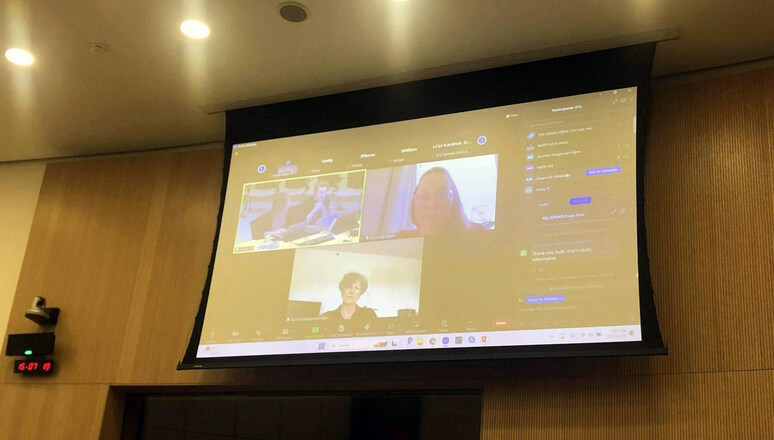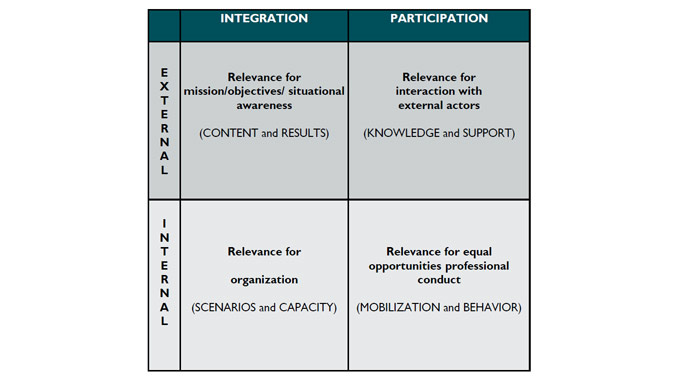Deep Dive Recap: The High North and the Gender Perspective
On 21 February 2024, the NATO International Military Staff (IMS) Office of the Gender Advisor convened its final Deep Dive session of the regional series, discussing the High North and the Gender Perspective. It focused on the complex intersection of gender and regional security threats, including hybrid attacks. It also discussed the intersection of gender with other marginalised identity markers, as well as categories for gender analysis in preparing for, preventing and responding to security threats in the High North.

Subject matter expertise was provided by Dr Gunhild Hoogensen Gjørv from the Arctic University of Norway and Dr Louise Olsson, Research Director at the Peace Research Institute, Oslo (PRIO).
Dr Hoogensen Gjørv emphasised the importance of using a gender lens to evaluate the effectiveness of international operations. She noted that the intersection of gender and other identity factors such as ethnicity and socioeconomic status has an impact on today's geopolitical landscape. Therefore, to understand the various positions we take, we must first understand gender as part of a larger cosmos of identities. She also stated that, even within democratic societies, these various identity groups do not yet have equal rights, and it is critical to understand how this affects our security.
Dr Hoogensen Gjørv identified hybrid threats as a major security concern in the High North, characterised by extensive intelligence gathering and hacking incidents. She explained that the proximity of Russia's military installations in the polar peninsula adds another layer of complexity, as sensitive areas such as civilian airports and societal structures have been targeted. These threats extend beyond traditional military tactics, exploiting societal cleavages, including gender inequalities, to destabilise and polarise democratic societies. She cited disinformation campaigns during Finland's elections, which targeted the female Prime Minister and exploited existing societal prejudices to cast doubt on a woman’s ability to lead. Migration was highlighted as another focal point for hybrid attacks, with disinformation exacerbating pre-existing prejudices to heighten fear and increase distrust. To address these challenges, Dr Hoogensen Gjørv emphasised the importance of understanding the civilian domain and the role of gender as well as other intersectional identities in shaping societal dynamics and vulnerabilities.
Dr Olsson began her presentation by detailing a matrix she developed for systematically addressing the Gender Perspective in military organisations and operations in four key areas (henceforth referred to as the PRIO Matrix): 1) external integration, 2) external participation, 3) internal integration and 4) internal participation. She then used this matrix to identify key points when addressing security in the High North. Beginning with external integration, Dr. Olsson discussed integrating the Gender Perspective into the formulation and interpretation of the organisation’s regular visions, objectives and priorities, as well as their relevance for situational awareness. Understanding the societal impacts of conflict, particularly for vulnerable groups, is a necessary starting point for effective integration. Ukraine’s defence against the Russian invasion provides important lessons learned. The direct targeting of civilians, including conflict-related sexual violence, as well as the impact on refugee movements and internal displacement, all pose different risks to men, women, boys and girls. Similarly, military targeting of civilian infrastructure such as hospitals, water and electricity infrastructure, have significant and specific consequences for women’s health and security. This targeting may also reinforce and complicate women’s social responsibility to care for vulnerable populations. This affects women’s ability to contribute to other critical aspects of societal functionality. To that end, the gendered societal impact of conflict can have implications for military capacity development, such as determining responsibility for dealing with violence against civilians and allocating resources between military and civilian defence tasks and objectives.

Copyright: Louise Olsson, PRIO
Dr Olsson then discussed external participation, which refers to the importance of inclusion and gender awareness in interactions with actors outside the defence sector. She observed that the division of roles and responsibilities in a society is an important entry point because this distribution is often gendered, even in countries with high levels of gender equality. For instance, while Sweden has made significant progress, the labour market is divided along gender lines, with men dominating military defence and women dominating civilian institutions central for defence and resilience. To ensure legitimacy and diverse voices, she emphasised the importance of inclusion, in terms of both number and the actual influence. It is important to determine who has a voice, who is considered an expert and on what, as well as where and from whom the information that underpins central decisions is gathered. These considerations can improve decision-making capacity in security and defence. This is true not only for women, but also for marginalised groups with a stake in the security of the High North, particularly indigenous populations.
When discussing internal integration, Dr Olsson emphasised the importance of building organisational capacity and fine-tuning internal processes so that a military organisation can work systematically from the Gender Perspective. A critical starting point is the ability to collect and analyse gender-disaggregated data in the relevant geographical area, including intersectional factors, such as age, ethnic background and socio-economic status. This analysis reveals patterns of potential outcomes while also identifying relevant vulnerabilities. Such an analysis can be strengthened further by conducting research and reporting to help unpack empirical trends and factors over time. Finally, in order to translate this understanding into integrated aspects of tasks and activities, she emphasised the importance of education, training and exercises. This includes regional exercise scenarios for assessing how to effectively and relevantly integrate gender into future military planning and operations.
Dr Olsson concluded her presentation by addressing internal participation. While this is frequently discussed in terms of female personnel recruitment and retention, there is another important dimension to consider: mobilisation during a crisis. For example, government support for child and elderly care promotes high labour participation. Given the current gendered labour distributions at home, many women may be unable to mobilise if child and elderly care are not supported during a crisis. This can affect both military and civilian defence.
Finally, internal participation entails considering aspects of professional conduct, particularly the prevention of harassment and abuse. Such behaviour has a serious impact on both the individual and the effectiveness of military units. Furthermore, it may indicate a risk of sexual exploitation and abuse of civilians during a crisis. This potential issue should be framed in terms of the need to understand how conflict increases the vulnerability of already vulnerable groups in order to mitigate compounding risks such as sexual violence.
Dr Hoogensen Gjørv and Dr Olsson’s presentations both underlined that gender is an important factor shaping security paradigms in the High North. Hybrid campaigns underscore the importance of recognising and addressing gender disparities in democratic societies, as well as the vulnerability of marginalised groups to destabilisation tactics. The PRIO matrix outlines a roadmap for incorporating the Gender Perspective into military planning, emphasising the importance of identifying civilian vulnerabilities, improving decision-making capacities and using gender-disaggregated data. Integrating the Gender Perspective is a strategic imperative for building resilience and inclusivity in the face of evolving threats in the High North.
